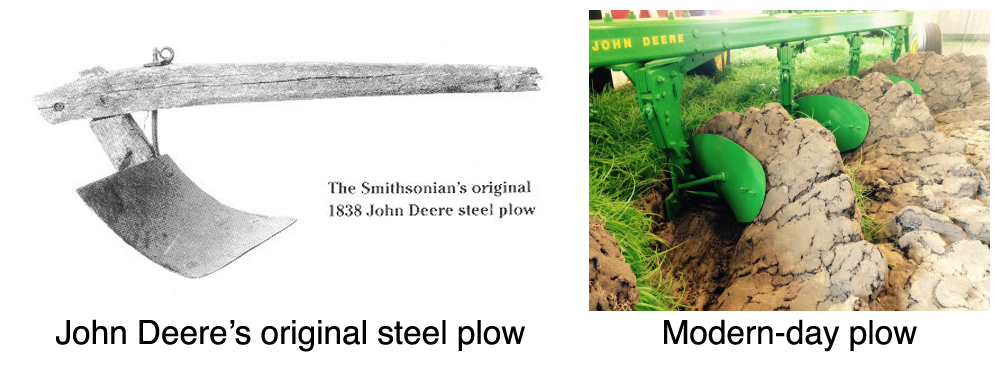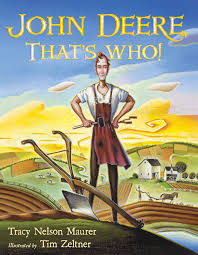Agricultural Literacy Curriculum Matrix
Lesson Plan
John Deere, That's Who!
Grade Level
Purpose
Students explore how producers and consumers work together to meet human needs by using the book John Deere, That’s Who! Grades K-2
Estimated Time
Materials Needed
Activity 1: Producers and Consumers
- Producers and Consumers Puzzle
- Construction Paper
- Various art supplies (scissors, crayons, colored pencils, glue)
Activity 2: Blacksmith for a Day
- Blacksmith for a Day Scenarios
- Tinfoil, one or two 12X12 sheets per student
- Popsicle sticks
- Various art supplies (scissors, tape, glue, construction/card stock paper)
Vocabulary
blacksmith : a person who makes and repairs things made out of iron and steel
consumer: a person who buys and uses goods and services
crop residue: plant material remaining in a field after harvesting, including leaves, stalks, and roots
plow: a farm implement with one or more blades, drawn by a tractor or by animals used for cutting furrows in the soil and turning it over, to prepare for the planting of seeds
producer: a person or company that makes, grows, or supplies goods or services
Did You Know?
- Farmers originally used wooden plows because they thought iron and steel would poison the soil.1
- Gumbo is a term used to describe soil that is very sticky and heavy.1
- Since John Deere manufactured his first plow in 1837, approximately 596 different tractor models have been designed, produced, and sold.2
Background Agricultural Connections
Why do farmers plow their fields? Plowing is used for a number of reasons including preparation for planting seeds, breaking up the chunky soil structure, and turning the top layer of organic matter or crop residue down into the soil. The process of plowing makes it easier for farmers to plant seeds and aids in water drainage and root growth.
Farmers typically plow their fields in the fall after they harvest their crops. Plowing in the fall after the crops are harvested helps farmers prepare the land and soil for planting seeds in the spring.
In 1837, a blacksmith by the name of John Deere invented the first steel plow. During this time, farmers used horses to pull a single-bladed plow through the field. Today, farmers use tractors to pull a single plow with multiple blades. This allows more plowing to be done in a shorter amount of time.

Engage
- Ask students, “What does it mean to produce something?” Allow several students to answer and discuss different options. Next, ask, “What is a producer? Who would be an example of a producer?” Explain that producers can produce either a good or a service.
- After discussing producers, ask the students what it means to consume. Some students might respond that consume means to eat. Explain that consuming does mean eating, but it can also mean buying a good or service from producers. Discuss that producers provide goods or services and consumers buy or use those goods and services.
- Ask students about various people in the community and different careers. Do these people/careers produce goods or provide services for us? (ex. A chef produces meals for us to eat, a baker produces breads and cakes, a police man provides services by keeping the community safe, etc.) Who are the consumers of these producers?
- Explain that producers see what other people need, and provide that good or service for them.
- Ask the students if they have ever heard of John Deere. Allow students to answer; some of them might recognize that their family has a John Deere lawnmower or they’ve seen a tractor before. Explain to students they are going to learn about a man named John Deere and how he became a famous producer for farmers in Illinois.
Explore and Explain
 Activity 1: Producers and Consumers
Activity 1: Producers and Consumers
- Read the book John Deere, That’s Who! by Tracy Nelson Maurer.
- Ask students, “Who is the producer in this story? Who is the consumer? Can someone be a producer and a consumer?” Discuss these questions as a class and allow students to share some ideas.
- Pass out the Producers and Consumers Puzzle to each student. Students will need to cut out each puzzle piece, assemble the puzzle in the correct order, and glue it to construction paper or card stock. This puzzle will show students how the producers and consumers in the book worked together to meet human needs.
- Instruct students to color and illustrate a small picture on each puzzle piece representing the producers and consumers.
Activity 2: Blacksmith for a Day
- Pass out a variety of materials (tinfoil, toothpicks, tape, etc.) for each student or group of students. This activity can either be done in pairs or individually. Explain to students that they are now blacksmiths who make things out of metal.
- Give the students a scenario in which someone is in need of a new piece of equipment, just like John Deere and the farmers of Illinois. This should get the students thinking about inventing and producing something that meets the needs of other people. The tinfoil represents metal used by a blacksmith, and the popsicle sticks represent any wood that might be needed. Encourage students to be creative. The Blacksmith for a Day Scenarios document provides some example scenarios. Students can work individually or in groups. The same scenario can be given to the entire class or different scenarios to each group or student.
- After the students have produced models of the items they think will meet the needs of the consumers in the scenarios, have them share their ideas with the class.
- Discuss the different scenarios with students. Use the following questions to guide the discussion:
- Who are the consumers in each scenario?
- Do the students' products meet the needs of consumers?
- Will the products help agriculturists (farmers) in their community?
Elaborate
-
Discuss other agricultural innovators and the goods and services they provided for farmers and consumers by reading the following books:
- Norman Borlaug: The Boy Who Changed the World
- George Washington Carver: A Weed is a Flower
- Temple Grandin: The Girl Who Thought in Pictures
- George Washington: Farmer George Plants a Nation
- Eli Whitney: Eli Whitney and the Cotton Gin
-
Self driving tractors? Use the Tractor History timeline to discover how tractor technology has changed since the first gas powered tractor was introduced to the farming industry in 1890.
Evaluate
After conducting these activities, review and summarize the following key concepts:
- Producers provide goods or services for consumers who purchase the goods and services.
- Inventors work to design products that meet the needs of other people.
- John Deere invented the first steel plow in 1837. The John Deere company went on to produce many other products that help farmers do their jobs.
Sources
- John Deere, That's Who! by Tracy Maurer
- http://blog.machinefinder.com/14920/10-surprising-facts-you-may-not-know-about-john-deere
Recommended Companion Resources
- A Weed Is a Flower: The Life of George Washington Carver
- Agricultural Inventions: At the Top of the Field
- Big Tractor
- Eli Whitney and the Cotton Gin
- Farmer George Plants a Nation
- Hero for the Hungry: The Life and Work of Norman Borlaug
- John Deere's Powerful Idea: The Perfect Plow
- John Deere, That's Who!
- Machines on the Farm
- The Boy Who Changed the World
- The Girl Who Thought in Pictures: The Story of Dr. Temple Grandin
- Tractor Timeline- A History of Tractors
Author
Organization
| We welcome your feedback! If you have a question about this lesson or would like to report a broken link, please send us an email. If you have used this lesson and are willing to share your experience, we will provide you with a coupon code for 10% off your next purchase at AgClassroomStore. |





